| Palaeocephala | |
|---|---|
| Scientific classification | |
| Kingdom: | |
| Division: | |
| Class: | |
| Order: | |
| Family: | |
| Genus: | Palaeocephala |
| Type species | |
| Palaeocephala cymatelloides | |
Palaeocephala is a genus of fungi. This is a monotypic genus, containing the single species Palaeocephala cymatelloides, described by Rolf Singer in 1962. [1] According to the Dictionary of the Fungi, the genus is classified in either the Marasmiaceae or Physalacriaceae families; [2] the taxonomical database MycoBank includes it in the Marasmiaceae. [3]

Omphalotus is a genus of basidiomycete mushroom, in the family Marasmiaceae, formally circumscribed by Victor Fayod in 1889. Members have the traditional cap and stem structure. They are saprobic, and fruit in clumps on the ground, adjacent to host trees. The best known and type species is the jack-o'-lantern mushroom (Omphalotus olearius). Species of Omphalotus have been mistaken for chanterelles. All Omphalotus species are presumed poisonous, causing gastrointestinal symptoms. Some Omphalotus species have bioluminescent properties.

Lentinula is a small genus of wood-inhabiting agarics. The neotropical species Lentinula boryana is the type species. However, the best-known species is L. edodes, the shiitake. The genus, erected by Franklin Sumner Earle in 1909, contains eight species, principally found in tropical regions.

Pseudohiatula is a genus of fungi in the family Physalacriaceae. It was originally described as a subgenus of Mycena by the mycologist Rolf Singer before he moved to its own genus two years later. It was formerly thought to belong in the family Tricholomataceae, but a molecular phylogenetics study found it to be more closely The genus Cyptotrama in the Physalacriaceae. Rolf Singer had previously hypothesized these two genera to be closely related based on morphological features in 1986. It contains five species that are widely distributed in tropical areas.
Calathella is a genus of fungi in the mushroom family Marasmiaceae. According to the Dictionary of the Fungi, the genus contains nine species found in Europe and North America. The genus was circumscribed by the English mycologist Derek Reid in 1964.
Epicnaphus is a genus of mushroom-forming fungi in the family Marasmiaceae. The genus, circumscribed by mycologist Rolf Singer in 1960, contains two species found in South America. Fruitbodies of Epicnaphus species are similar in appearance to those in Marasmius section Sicci, but have a smooth hymenium and broom cells of the Rotalis-type. Singer initially included only the type species, E. phalaropus, which was originally collected from fallen branches in a Bolivian rainforest. The Argentinian species E. longispora was added to the genus by Jörg Raithelhuber in 1973.
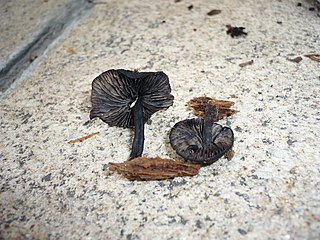
Hydropus is a genus of fungi in the family Marasmiaceae. The widespread genus contains about 100 species, especially in tropical areas, but is not well represented in temperate regions. About 15 taxa are found in Europe; H. floccipus has the widest distribution in western Europe. Hydropus was circumscribed by Rolf Singer in 1948. Species in the genus have fruit bodies with caps that are mycenoid, collybioid, or omphaloid in form. Most species occur in tropical and subtropical regions, where they grow as saprobes on rotting wood, forest litter, and mosses. Generally, most Hydropus species are rare, and several are known only from the type collection, including H. conicus, H. moserianus, H. nitens, and H. paradoxus.

Lactocollybia is a genus of agaric fungi in the family Marasmiaceae. The widespread genus contains 17 species, many of which are found in tropical areas.

Mycetinis is a genus of fungus in the Omphalotaceae family, containing about eight species formerly classified in Marasmius.

Moniliophthora is a genus of fungi in the family Marasmiaceae. The genus was described in 1978 with M. roreri as the type species. This fungus, formerly known as Monilia roreri, causes frosty pod rot, a serious disease of Theobroma cacao.
Nothopanus is a genus of fungus in the family Marasmiaceae. The genus was circumscribed by American mycologist Rolf Singer in 1944.
Skepperiella is a genus of fungus in the family Marasmiaceae. The widespread genus contains four species. The genus was circumscribed by Albert Pilát in Bull. Soc. Mycol. France vol.43 on page 56 in 1927.

Paragyrodon is a genus of fungi in the family Paxillaceae. It is a monotypic genus, containing the single species Paragyrodon sphaerosporus. Paragyrodon was circumscribed by Rolf Singer in 1942.
Episphaeria is a genus of fungus in the Agaricales. The genus is monotypic, and contains the single rare species Episphaeria fraxinicola, found in Europe. Its familial position is not known with certainty. The tiny fruit bodies of the fungus resemble minute, white cups that grow scattered or in groups on the bark of ash trees.
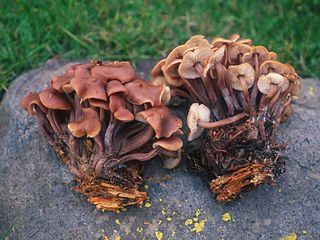
Connopus is a fungal genus in the family Marasmiaceae. The monotypic genus was circumscribed in 2010 to accommodate the species Connopus acervatus, formerly in the genus Gymnopus. It is found in North American and Europe, where it grows in dense clusters on decaying wood. It is regarded as inedible.
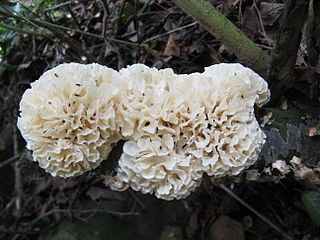
Hydnopolyporus is a genus of two species of fungi. The genus was circumscribed in 1962 by English mycologist Derek Reid with H. fimbriatus as the type species.
Nothopanus noctilucens is a species of agaric fungus in the family Marasmiaceae. Found in Japan, the fruit bodies of the fungus are bioluminescent.
Omphalotus mangensis is a species of agaric fungus in the family Marasmiaceae. Found in China, the fruit bodies of the fungus are bioluminescent.
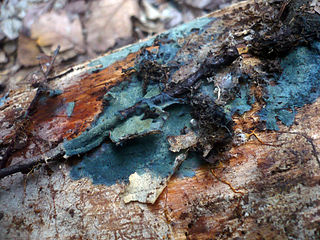
Byssocorticium is a genus of corticioid fungi in the family Atheliaceae. The widespread genus contains 9 species.
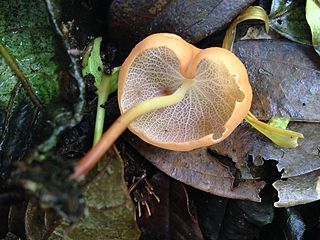
Marasmius cladophyllus is a species of fungus in the family Marasmiaceae. Found in South America and Central America, it was described as new to science by English mycologist Miles Joseph Berkeley in 1856. A characteristic feature of the mushroom is the prominent ventricose (vein-like) pattern of the gills.
Crinipellis rhizomaticola is a species of fungus in the family Marasmiaceae. Found in Korea, where it grows in open woodland with Japanese red pine, the fungus was described as a new species in 2009.